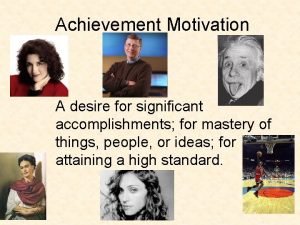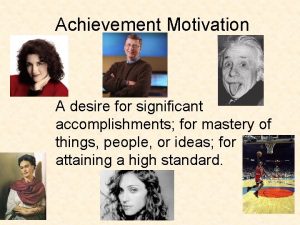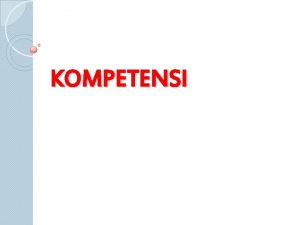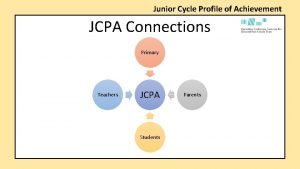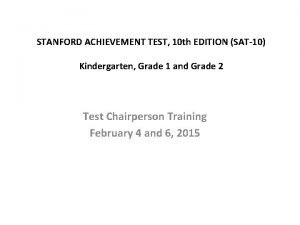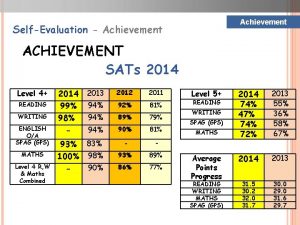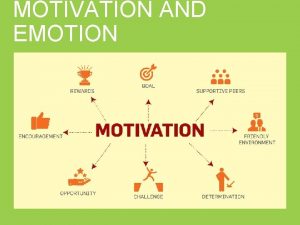Personal Motivation and Achievement Personal Motivation and Achievement












































- Slides: 44

Personal Motivation and Achievement

Personal Motivation and Achievement Every individual can be well motivated to achieve success in work and in personal life. High motivation facilitates achieving high productivity and quality. It is important for career building and promotion.

Personal Motivation and Achievement n Self-discipline can motivate you and achieve your goals.

Personal Motivation and Achievement n Motivation: It is a drive. It is an internal force to do and achieve personal and organizational goals.

Personal Motivation and Achievement n NEEDS, WANTS and MOTIVATION

Personal Motivation and Achievement n Personal needs and wants drive to work towards achieving certain goals. In other words, Motives are linked with personal needs or desires.

Personal Motivation and Achievement n The Need Theory of Motivation

Personal Motivation and Achievement n Personal needs and wants motivate people until these are satisfied.

Personal Motivation and Achievement n The need cycle shows the relationship with work and achievement:

Personal Motivation and Achievement n Need Drive Actions Satisfaction. The need cycle repeats itself, making it difficult to every truly satisfy people.

Needs and Motivation n n n n Important Needs/Wants: Work and personal life offer the opportunity to satisfy several needs and wants. 1. Achievement. Personal achievement of needs lead people to find joy and satisfaction. 2. Power. The need or want for power compel people to control resources including people and money. 3. Affiliation. People who value relations tend to be loyal to organizations and also with other people. 4. Recognition. People with a strong need for recognition wish to be acknowledged for their contribution and efforts. 5. Discipline. People with a strong need for discipline and order have the urge to put things in order. 6. Risk Taking and Thrill Seeking. People with a strong need for risk taking and thrill seeking need exciting events and stimulation. 7. There may be a multitude of other needs and wants that drive or motivate people to do different things or tasks.

Maslow’s Hierarchy of Needs

Maslow’s Hierarchy of Needs Maslow’s hierarchy of needs show that people strive to satisfy the following needs in a sequential order: Physiological Safety Social Esteem Self-Actualizing

Maslow’s Hierarchy of Needs A person is a perpetually wanting animal.

Maslow’s Hierarchy of Needs n The higher the level of need, the less likely it is to be satisfied.

Maslow’s Hierarchy of Needs n People will make efforts to satisfy those needs which are important for the individual. The first step, however, is the identification of a need or set of needs.

Goal Setting and Motivation What is a goal? A goal is an event, circumstance, object, or condition a person strives to achieve.

Goal Setting and Motivation Goals are useful because they: (a) Provide a Consistent Direction (b) Improve the Chances for Success (c) Serve as Self-Motivators and Energizers. Combined with self-Efficacy, the contribution of goals is even more important.

Goal Setting and Motivation n n Goals create a discrepancy between what exists and personal aspirations. Such a discrepancy leads to dissatisfaction and turn into a drive or motive to eliminate the discrepancy.

Goal Setting and Motivation Neurological Perspective n Goals are Different Types n A Proving-Goal Orientation n Learning-Goal Orientation Attempting to Master Skills

Goal Setting and Motivation n n From a neurological perspective, goals arouse the sympathetic nervous system to action. Overly demanding goals, however, may produce over-arousal; the person becomes over-stimulated and may back away from achieving the set goal.

Goal Setting and Motivation n Goals are different types. It may involve learning or doing things or tasks. A learning -goal orientation means than an individual is focused on acquiring new skills and mastering new situations.

Goal Setting and Motivation n A proving-goal orientation is aimed at wanting to demonstrate and validate the adequacy of one’s competence by seeking favorable judgments about one’s competence.

Goal Setting and Motivation n People with a learning-goal orientation are more likely to seek feedback on how well they are performing.

Goal Setting and Motivation n Attempting to master skills often leads to better results than does attempting to impress others.

Goal Setting on the Job n n n Goal Setting is Important Executives set Strategic Goals Priority Setting Importance of Personal Goals Integrating Personal and Career Goals

Goal Setting on the Job n Goal setting is important in both profit and nonprofit firms, especially in technical, professional, and managerial jobs.

Goal Setting on the Job n Executives set strategic goals. Workers at lower levels establish goals that support the top -level strategic goals.

Goal Setting on the Job n An important part of goal setting, both on and off the job, is priority setting.

Goal Setting on the Job n An important part of goal setting, both on and off the job, is priority setting.

Goal Setting on the Job n If you want to lead a rewarding personal life, you should have goals and plans to achieve them.

Goal Setting on the Job n Personal goals heavily influence formulation of career goals as well. the

Goal Setting on the Job n Integrating personal and career goals creates balance and stability in life.

Types of personal goals n Personal goals can be divided into different groups: Social and Family n Hobbies and Interests n physical and Mental Health n Financial n

Types of personal goals n An action plan is needed to achieve those goals.

Guidelines for Goal Setting n n n Specify Goals Concise Goals Set Realistic Goals Set Goals for Different Time Periods Include Some Fantasy in Your Personal Goal Setting Review Your Goals from Time to Time

Guidelines for Goal Setting 1. Specify Goals: Vague goals may delay action. 2. Concise Goals. Use a short, punchy statement. 3. Set Realistic Goals. A realistic goal represents the right amount of challenge for the person pursuing the goal. The higher a person’s self-efficacy, the more likely he or she may think that a goal is realistic. 4. Set Goals for Different Time Periods. Include daily, shortrange, medium-range, and long-range goals. 5. Include Some Fantasy in Your Personal Goal Setting. Fantasy goals reflect a vision of the ideal type of life one would like to lead. Such goals also facilitate relaxation. Goals om e. Review Your 6. relevance and therefore must be changed.

Problems Related with Goals n n Inflexibility Narrow Focus May Detract Interest in the Task Can Interfere with Relaxation

Problems Related with Goals n n A major problem related with goals is that goals can create inflexibility. Goals can contribute to a narrow focus, thus neglecting other worthwhile activities. Performance goals can sometimes detract from an interest in the task. Another problem is that goals can interfere with relaxation.

Techniques of Self-Motivation n n n Set Goals for Yourself Find Intrinsically Motivating Work Get Feedback on Your Performance Apply Behavior Modification to Yourself Improve Your Skills Relevant to Your Goals Raise Your Level of Self-Expectation Develop a Strong Work Ethic

Techniques of Self-Motivation n n Identifying your most important needs could enhance motivation. Some other techniques are also important to learn about. 1. Set goals for yourself. Goal setting is fundamental to motivation. 2. Find intrinsically motivating work. Intrinsic motivation refers to the natural tendency to seek out novelty and challenges, to extend and use one’s capabilities. 3. Get feedback on your performance. Feedback acts as a reward. 4. Apply behavior modification to yourself. In using behavior modification, remember that self-rewards may be more effective than self-punishments in sustaining the right behavior.

n n n 5. Improve your skills relevant to your goals. According to the expectancy theory of motivation, people need confidence in their skills to be motivated. 6. Raise your level of self-expectation. The Galatea effect is the technical term for improving performance through raising one’s expectations. 7. Develop a strong work ethic. If you are committed to the idea that most work is valuable and that it is joyful to work hard, you will automatically become strongly motivated.

Self-Discipline and Motivation n n n Achieving goals and staying motivated requires self-discipline. The ability to work systematically and progressively toward a goal until it is achieved. The components of the self-discipline are as follows: 1. Formulate a mission statement related to your life 2. Develop role models of self-disciplined achievers. 3. Develop goals for each task. 4. Develop action plans to achieve goals. 5. Use visual and sensory stimulation. Self-disciplined people form mental images of the act of accomplishing what they want.

Self-Discipline and Motivation n 6. Search for pleasure within the task. A selfdisciplined person finds joy, excitement, and intense involvement in the task at hand (intrinsic motivation). 7. Compartmentalize spheres of life. Self-disciplined people have a remarkable capacity to divide up (compartmentalize) the various spheres of life to stay focused on what they are doing at the moment. 8. Minimize excuse making. Self-disciplined people concentrate their energies on goal accomplishment rather than making excuses for why work is not accomplished.
 Achievement motivation is the desire for
Achievement motivation is the desire for The desire for significant accomplishment for mastery
The desire for significant accomplishment for mastery Organizational theory pmp
Organizational theory pmp Nach sporting examples
Nach sporting examples Is the desire to make significant accomplishments
Is the desire to make significant accomplishments Kaufman test of educational achievement pros and cons
Kaufman test of educational achievement pros and cons Contoh tes prestasi
Contoh tes prestasi Ethnocentric curriculum
Ethnocentric curriculum Teaching excellence and achievement
Teaching excellence and achievement Woodcock johnson iv bell curve
Woodcock johnson iv bell curve Wrat 4
Wrat 4 Stanford 10 test
Stanford 10 test Industrial achievement performance model
Industrial achievement performance model What is communicative achievement
What is communicative achievement Provincial achievement tests
Provincial achievement tests Tugas stadier
Tugas stadier Self achievement adalah
Self achievement adalah Hse performance achievement template
Hse performance achievement template Peabody testi formu
Peabody testi formu Contoh tes performansi tipikal
Contoh tes performansi tipikal Kemampuan eksekutif untuk membangun hubungan baik dengan
Kemampuan eksekutif untuk membangun hubungan baik dengan Junior cycle profile of achievement sample
Junior cycle profile of achievement sample Achievement vs aptitude tests psychology
Achievement vs aptitude tests psychology Achievement test adalah
Achievement test adalah Growing success report card comments
Growing success report card comments Logo achievement
Logo achievement Task achievement scaling social work
Task achievement scaling social work Alfred binet ap psychology definition
Alfred binet ap psychology definition What is your virtuous achievement as a professional
What is your virtuous achievement as a professional Achievement standards network
Achievement standards network Skala wechsler
Skala wechsler Inclusive
Inclusive Sam reading inventory
Sam reading inventory Hse performance achievement
Hse performance achievement Higher education achievement report
Higher education achievement report Child beauty pageants history
Child beauty pageants history Pat maths band descriptions
Pat maths band descriptions Mayan civilization achievements
Mayan civilization achievements Achievement measure worksheet
Achievement measure worksheet Achievement
Achievement Stanford achievement test kindergarten
Stanford achievement test kindergarten Woodcock johnson oral language
Woodcock johnson oral language Record of school achievement
Record of school achievement Idaho standards achievement test
Idaho standards achievement test Ohio achievement test
Ohio achievement test

